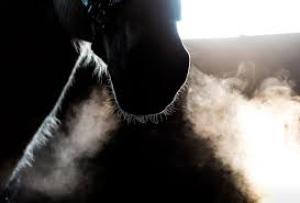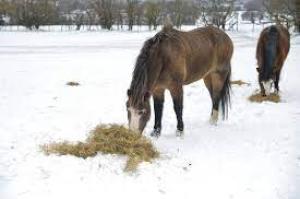
By Vet Charlotte Pennington
Over the winter we do tend to see an increase in respiratory disease in horses. Winter weather means horses are stabled for longer periods of time. This can lead to increased exposure to environmental irritants such as airborne dust, causing inflammation of the horse’s airways, and symptoms such as coughing, nasal discharge and exercise intolerance. Although common infectious diseases (e.g. equine influenza, herpes and strangles) can be spread all year round, stabling horses for longer periods of time can be stressful for horses and lead to increased close contact and shared air spaces. All of these factors potentially increase the risk of spreading infectious diseases. It is important to keep up to date with your horse's routine vaccinations to reduce the risk of disease.
Where infectious disease is suspected, samples are usually taken to help identify the cause such as nasopharangeal swabs or blood samples.

It is important when infectious disease is suspected to isolate affected horses immediately to prevent further spread. Movement of horses on/off the yard should be restricted until a diagnosis is confirmed and a plan in place. Biosecurity is very important as infected horses can easily contaminate people’s clothes, hands and equipment such as rugs, buckets and brushes. If the same handler then goes on to care for other unaffected horses or uses shared equipment then there is a huge risk of spread. Other horses on the premises should be monitored for any signs of infection such as nasal discharge or high temperatures.
Individual treatment varies depending on the cause but may involve anti-inflammatories to reduce any high temperatures or in certain cases antibiotics and other supportive therapy.
Where non-infectious airway irritation is suspected the vet may suggest further testing such as passing a camera into the airway to view the structures and check for signs of inflammation. Samples such as tracheal washes can then be taken from the airway directly and sent off to assist diagnosis.
It is a good idea to check the teeth and look in the horse's mouth as occasionally sinus or dental disease can lead to problems with the airways.

Hay and bedding are common sources of particles causing winter allergies. In the case of an allergic irritation initial treatment with steroids to settle the inflammation may be advised. Whilst medication can settle initial flare-ups, they should not be used alone. Management changes need to be put in place to prevent future exposure and irritation occurring such as; avoiding straw and using dust extracted bedding; mucking out without the horse in the stable, or put new bedding down to reduce dust exposure; consider where hay bales and straw are stored in relation to the horse’s stable; ensuring good ventilation, air flow and drainage in the stable; feeding hay/feed from the ground to encourage drainage of mucus from airways; soaking hay for at least 60 minutes prior to feeding to reduce the dust levels (but not the nutritional content for which longer soaking is needed); steaming hay is very beneficial as the high temperatures kill mould spores (however it is a significant investment for the steamer machines); discarding and not feeding any mouldy hay/hay ledge and finally ensuring turnout where possible (assuming the horse is not allergic to anything in the pasture!)
Despite best efforts and management changes some horses with allergies do require long term medication. The safest and most cost- effective way to administer this is via an inhaler or nebuliser which puts medication directly into the airway and reduces the side effects of oral medication e.g. steroids and laminitis risk.